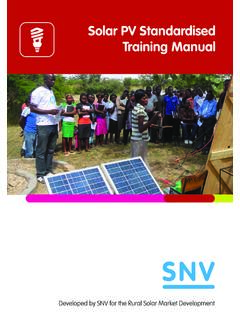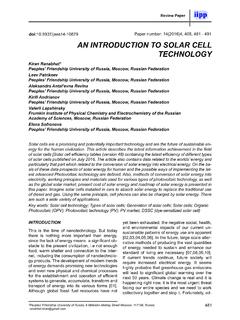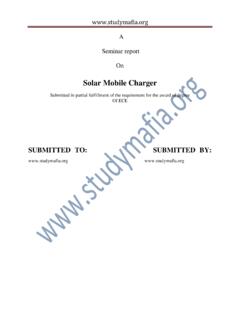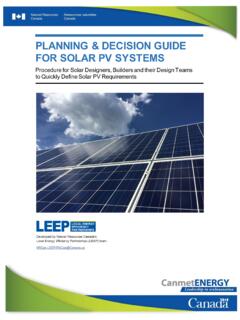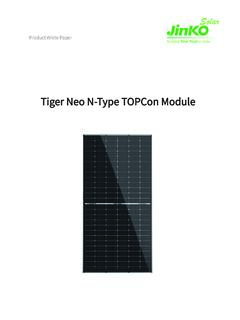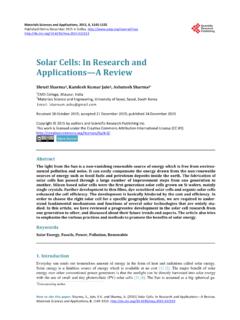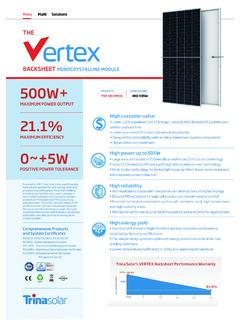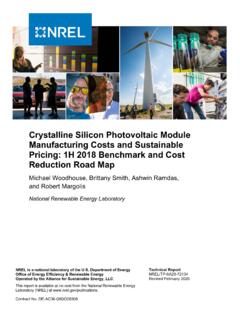Transcription of Solar PV Training & Referral Manual
1 Solar PV Training & Referral ManualDeveloped by SNV for the Rural Solar Market DevelopmentAbout This ManualThis Pico PV Referral Manual has been developed by SNV Zimbabwe to provide distributers, installers and users of PV systems with a quick reference and source of information. The Manual coversthe following:a) Background on Solar Technologyb) Solar Systemsc) Basic System Sizingd) Troubleshooting Guidancee) Safety PrecautionsThe Manual is designed for use by anyone who wishes to obtain quick, basic, technical information with regards to PV systems. However, it is particularly targeted at those who engage in the business of distributing and installing PV products.
2 This manualdoes not guarantee the quality of installations carried out by installers nor the quality of products supplied by is recommended that all installations are carried out in a responsible and professional way. All electrical work shouldbe performed by a qualified electrician to guarantee theinstallation and/or SNVSNV is a not-for-profit international development organisation. Founded in the Netherlands nearly 50 years ago, we have built a long-term, local presence in 38 of the poorest countries in Asia, Africa and Latin America. Our global team of local and international advisors work with local partners to equip communities, businesses and organisations with the tools, knowledge and connections they need to increase their incomes and gain access to basic services empowering them to break the cycle of poverty and guide their own 1: Background onSolar TechnologyWhat is Solar Energy?
3 Solar HeatingSolar PV PhotovoltaicsWhy Solar Energy?Section 2: Solar SystemsElectricity Basics 10 Solar PV Photovoltaic SystemPortable PV SystemSolar Home SystemsSolar Panel (Module) Solar Charge Regulator/ControllerSolar BatteriesSolar InverterA summary of the Complete Solar Home SystemSection 3: Basic System Sizing:Practical ExercisesWorksheets 1-6 & Note SpaceUseful Information: Typical Power RatingsGeneral Troubleshooting NotesFrequently Asked Questions (FAQs)Appendix 1:Basic Anatomy of a MultimeterHow to Test Solar Panel OutputHot to Test a Solar Panel s PolarityHow to Check the Voltage on a Solar Panel Affected by Shade Battery Testing Using a MultimeterAppendix 2.
4 Supporting BookletHandy Pull-Outs & Troubleshooting ListsSupporting Booklet060607081012131516202328293240424 649505151525203 Training & Referral ManualABBREVIATIONSD egrees CelciusAmperesAlternating CurrentAmpere hoursDirect CurrentEnergyFrequently Asked QuestionGigawatt hourCurrentKilowattKilowatt hourMetres per secondMegajouleMegawattNon-Governmental OrganisationPowerPetajoulePhotvoltaicRes istanceRural Electrification AgencySolar home systemStandard Test ConditionsTelevisionVoltsWatts per square metreWatt hour CAACAhDCEFAQGWhIkWkWhm/sMJMWNGOPPJPVRREA SHSSTCTVVW/m2 WhSECTION 1:Background on Solar TechnologyIn this Unit:What is Solar Energy?
5 Solar HeatingSolar PV PhotovoltaicsWhy Solar Energy?06 Section 1: Background on Solar TechnologyWhat is Solar Energy? Solar Energy refers to radiant heat and light from the sun. It is renewable, which means it cannot be used up. It is harnessed and converted to heat or electricity using various technologies such as Solar Heating and Solar Photovoltaics (conversion to electricity). Solar Heating - Solar Energy to ThermalSolar thermal systems operate when radiation/heat from the sun is directed to a device which captures and concentrates the heat to a carrying media (air or water).
6 APPLICATIONS OR USES1. Heating water2. Heating rooms3. Solar drying & pasteurisationTraining & Referral ManualSolar Panel to Heat WaterSun Rays(Heat Energy)BOXTRANSPARENT TOPOUTLETINLETWarm Water OutCool Water InWATERPIPE07 Training & Referral ManualSolar PV (Photovoltaics) - Solar Energy to ElectricityPhotovoltaic (PV) means electricity from the technology is used to convert light energy into electrical is based on the characteristic of some semiconductor materials, such as silicon, which generate voltage and current when exposed to 1: Background on Solar TechnologySunlightHow a SolarPanel WorksLOADCURRENTn-typesiliconp-typesilic onjunctionphotonselectronflowholeflowAPP LICATIONS OR USES1.
7 Lighting2. Communication3. Powering electrical gadgets4. Water pumping5. Charging applicancesWhy Solar Energy?1. Reliability 2. Durability3. Low maintenance costs4. No fuel costs5. Reduced pollution6. Flexibility due to modularity7. Safety 8. Independence 9. Grid decentralisation10. High Altitude performance08 Training & Referral ManualSection 1: Background on Solar TechnologySECTION 2: Solar SystemsIn this Unit:Electricity BasicsSolar PV Photovoltaic SystemPortable PV SystemSolar Home SystemsSolar Panel (Module) Solar Charge Regulator/ControllerSolar BatteriesSolar InverterA summary of the Complete Solar Home System10 Training & Referral ManualSection 2: Solar SystemsElectricity BasicsMeasuring ElectricityVoltage (V): the potential difference in electrical charge between two points measured in (I).
8 The flow of electrons in a circuit/wire between two points measured in amperes. There are two types of current: 1. Alternating Current (AC) is the type of current most commonly used in households to power electrical appliances (for example TVs, refrigerators, radios and computers). Grid supplied electricity is alternating current. 2. Direct Current (DC) is produced by PV modules and stored in = Power CurrentV = P IVoltsCurrent = Power VoltsI = P VAmperesDirectCurrentAlternatingCurrentR esistance (R).
9 The opposition to the flow of electrical current in the material through which it is passing measured in ohms the potential difference in electrical charge between two points measured in = Volts CurrentR = V IOhmsWatts vs Watt-HoursA watt is the amount of powerthat a Solar panel can produce orthat a light bulb (Power)A watt-hour is the amount of energythat a Solar panel can produce or a lightbulb can consume in a certain anumberof (Energy)11 Training & Referral ManualSection 2: Solar SystemsPower (P): the rate of energy conversion measured in (E): refers to the capacity for work the power used over time, measured in = Volts x CurrentP = V X IWattsEnergy = Power x TimeE = P x tWatt-HoursExample:If a Solar panel produces 2 Amps of electricity at 12 volts, the total power it produces is 24 Watts.
10 (2 Amps x 12 Volts = 36 Watts)Electrical CircuitsLoads and power sources in a circuit can be connected in series or parallel. Systems may use a mix of series and parallel wiring to achieve the required voltages and voltage but does not increase increase current but voltage is not affected. 12 Training & Referral ManualSection 2: Solar SystemsSolar Photovoltaic (PV) SystemA Solar PV System converts Solar energy in form of light to electrical energy by the use of a Solar module ( Solar panel). Solar Irradiancefrom the SunSolarPanelChargeControllerBatterySyst emDC POWERAC POWER(and/or)ElectricCurrentInverterPhot ovoltaic systems consist of some or all of the following components: Solar Panel - Converts sunlight to electricity Battery(s) - Store electricity Charge Controller - Manages the flow of electricity between the Solar panel battery and load Inverter - Converts DC power from the Solar panel and battery to AC power.
